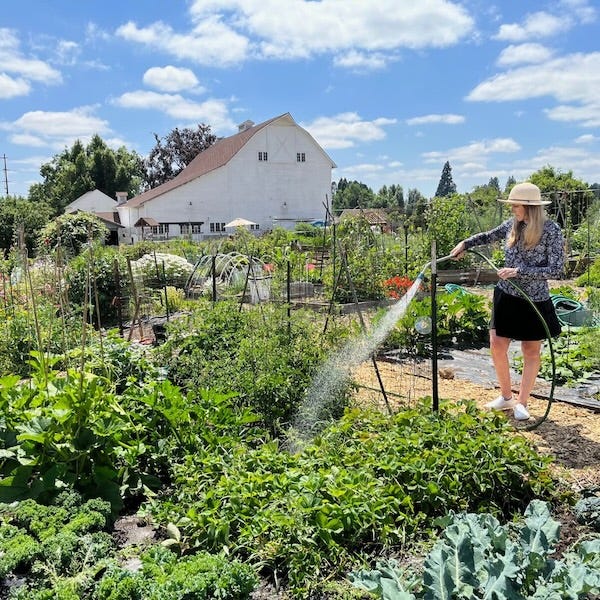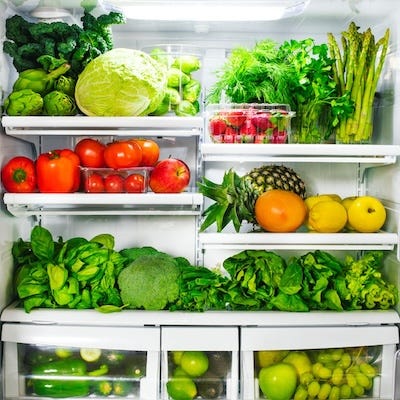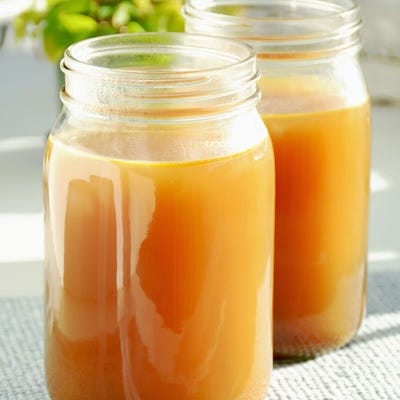Have you noticed the prices of produce lately? Shocking, right? Walking through the market has you second-guessing what you want to put into your cart.
Because it’s frustrating when you open up your refrigerator days later and find something wilting or rotting in the back. You spent good money on it! And now it’s going in the trash.
As a plant-based eater, I feel your pain. I can’t tell you how much produce I’ve thrown away these past few years.
You buy it for a recipe, using a small portion. You tuck it away with the best intentions.
You throw it away days later.
Can you relate?
I find this happens for one of three reasons.
We buy on a whim
I love going to my local market. The produce section is super motivating - the colors, the quality! Or the farmer’s market in the summer. It’s hard not to pick up fresh food as you wander the aisles.
It looks good. But when you get home, you forget it. You don’t have a plan. You move on to other things. And slowly, the fruit and veggies fade.
We buy without a goal
If you buy with a recipe in mind, you use it. If you create a menu plan, the fruits and veggies are consumed. If they are in a convenient location, you’re more likely to use them.
What is your goal? It’s the first place to start when you focus on using what you buy.
We get lazy
I’ve done this a lot. I plan meals for a week, only to have other activities pop up on my schedule. Suddenly, I can’t make something for dinner, and the produce sits in my fridge indefinitely.
Does any of this relate with you?
When I started watching my trash fill up with wilted and spoiled produce, I began looking for ways to change. Let me show you several simple hacks I’m using in my own life that you can simply incorporate into your own. When you see how simple they are, you’ll be wondering why you haven’t used them before.
Just for fun:
(Have you seen the charcuterie board video? My husband brought it to my attention because of her reaction to grape prices near the end. We’ve had that grape conversation multiple times this past summer. That could BE my husband! 🤣)
 Tiktok failed to load.
Tiktok failed to load.Enable 3rd party cookies or use another browser
Inventory and make a place for everything
I love my house. But if you ask me the one thing I’m not that fond of, it would be my fridge. It’s small. It’s not set up for plant-based life. But for now, I live with it.
And frankly, I think that’s most of us. I’ve watched videos and home improvement shows where the fridge has my eyes popping open wide. The fridges out there are truly gorgeous, especially for keeping fruits and veggies fresh for a long time.
[My daughter often says this is what my fridge looks like, though this definitely has more shelves. I really need an upgrade. 🤔]
But that’s not where I am. (And I bet you’re in a similar circumstance.)
My fridge isn’t perfect, but I make it work.
I shop more frequently. I’ve learned secrets to ensure I use what I purchase.
And I know if you shove every bag of produce onto one shelf or in a drawer, it wilts quicker and gets buried with the rest. Those plastic bags you find in the produce aisles will never do your food justice.
What I’ve learned to do instead is create sections for different foods. And I buy containers that extend the life of the foods I buy. Let’s talk specifics, and I’ll give you a few examples.
Tender greens are the most difficult. They’re the ones that usually end up slimy in the back of the fridge. Think arugula, spinach, spring mix, and other light greens. Hardier greens like kale, bok choy, Swiss chard, and others will last longer. The easiest way to increase the lifespan is to put dry paper towels or dish towels in the container to soak up extra moisture. I’ve purchased keepers that have moisture-releasing filters that work similarly. Don’t wash greens until you’re ready; added moisture weighs them down.
Asparagus is a vegetable I’m particularly fond of in the early summer. It also goes limp pretty fast. If you aren’t going to eat it quickly, place it in a water glass or mason jar as you would a bouquet. Fill it with a couple of inches of water, and place it in the fridge. Change the water if it gets cloudy.
Root vegetables can survive weeks in a cool, dry spot in your house. Avoid damp places, or you’ll see these same veggies try to take root. This includes potatoes, sweet potatoes, onions, beets, and yams. Carrots and radishes are considered root veggies, but they will last better in the fridge. Remove the greens and place them in a storage container. You can use the greens - they’re great in sauces like pestos or salsas. Nutritious too.
Winter squashes and pumpkins are similar to root vegetables. If you store them in a cool, dry spot, they can last for months. We grew pie pumpkins this past summer, used them throughout our house for decoration in October, then slowly used them for some of our favorite meals.
Zucchini and summer squash are best kept in the crisper drawer, or in a specialty storage container. They typically won’t last for more than a week or two, but they will freeze well if you cut them, blanch them, and freeze.
What I love about storage containers is they stack really well. I have multiple sizes, and can organize my fridge so I know what I have just by opening the door.
When everything has its place, it’s easy to see when something is running low. This is where an inventory comes in handy. If you know what you have and what you need, keeping it on hand is easier.
While I haven’t listed every fruit and veggie here, there are secrets for all. If you have specifics that you use repeatedly, it’s worth a Google search to learn how you can add longevity and keep it fresher, longer.
Live by a meal plan
Which brings me to the importance of a meal plan.
I remember when I once thought writing things down was a sign of weakness. Oh, was I young and naive!
Now, I have systems for everything, and it helps keep me on track and running efficiently in every aspect of my life.
Meal planning means I won’t choose meals based on a whim - that’s when I’m more likely to select not-so-healthy meals, or pick up the phone. Meal planning means I have a goal - and it makes shopping, planning, and cooking so much easier. Meal planning also prevents being lazy. I know what I’m having, so I have what I need on hand. I shop accordingly, and I make plans in my schedule for stepping into my kitchen and preparing meals.
I’ve tried this many ways, but I love good old-fashioned paper and pens. I’m a journal addict, and believe everything is better with a written plan. Journaling allows me to do that. It gives me a chance to record meals I love, look back at previous weeks, months, and seasons, find meals I love, and create a plan to keep me on track.
I also use a fridge menu board to see what’s on the menu each week at a glance.
It’s the easiest way to stay on track … and stay healthy.
And when I have leftover produce that starts looking a little rough around the edges …
Use leftovers … hello, smoothie!
If you’ve read my morning routine, you’ll know I’ve eaten the same smoothie for years … and I. Love. What. It. Does. For. My Body!
Honestly, I love it so much, that I even bring my BlendJet with me on vacation so I can whip up a smoothie wherever I am in the world.
At home, almost nothing goes to waste.
We take wilted kale, spinach, Swiss chard, cut it up and freeze it.
Sliced cucumber, zucchini, pumpkin, and sweet potato make great additions.
Fruit is an easy addition. If I need an orange rind while cooking, the rest goes into the smoothie. Pineapple, apples, berries, bananas, mangoes - we often buy it, freeze it, and in it goes.
Does everything work? Definitely not. I’m not one to put beets or onions in my smoothie. It’s more based on what it is and if it’s a good match - extra ginger and mint leaves went into the latest smoothie, and that added a lot of flavor.
Of course, smoothies aren’t the only place you can put old produce.
In so many cases, if you watch your produce, you’ll start to notice when they start turning. This gives you a chance to chop and put them in the freezer, or create recipes to freeze.
I love lasagna, chili, and soup, which are all easy, nutritious dishes that can take your leftover veggies and give them another way to do good for your body.
Or, make your own veggie broth! It tastes great, stores well, and is so much better (and better for you) than store-bought.
Veggie Broth
1 tablespoon coconut oil
1 medium onion, chopped
4 cloves garlic, chopped
4 carrots, chopped
4 stalks celery, chopped
9 cups filtered water
2 cups chopped greens (this is where you can mix and match. Use old kale, spinach, and collards. Use fresh herbs like parsley, thyme, and rosemary. Stick in those carrot tops. Yum!)
2 bay leaves
4 tablespoons tomato paste
4 tablespoons nutritional yeast
Salt and pepper, to taste
Directions:
In a large pot over medium heat, melt coconut oil. Add onion, garlic, carrots, and celery, and sauté until soft.
Add water, greens, bay leaves, tomato paste, and nutritional yeast. Bring to a boil, then reduce heat to a simmer and cover loosely with a lid. Continue cooking for 30 to 60 minutes. Longer cooking brings out more flavor. Adjust water, as needed, if cooking longer.
Let cool slightly, then pour over a strainer into another pot. Once cooled, divide into glass mason jars. Refrigerate for up to 5 days, or freeze for up to a month. You can freeze them in ice cube trays for a convenient way to add veggie broth to everything you make.
Again, this recipe is fully adjustable. Want to throw something else in? Give it a try. It will add flavor and nutrients to whatever recipe you add your veggie broth to, and reduce your need for less nutritious veggie broth you buy from the store.
Okay, that’s a wrap for today. I “dare” you to take a peek into your fridge, pull out the produce you might have forgotten about, and get creating!
Til next time,
Happy Fooding!
Lori









